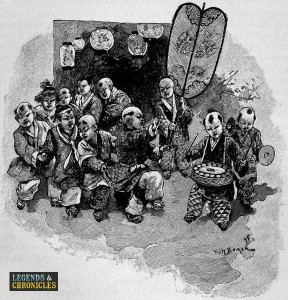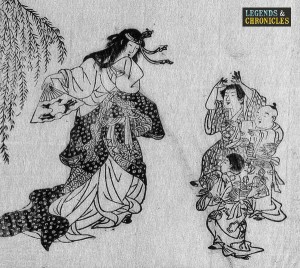Children in Feudal Japan
Like the children in Japan today, education and playing were biggest parts of childrens’ lives in feudal Japan. One of the main differences between today and feudal Japan’s children was the naming process for some. Several children in feudal Japan had multiple names throughout their lives, depending on which social class they were in. This meant their name at birth was different from their adulthood names.
Education for children in feudal Japan
There was a significant increase in the importance of education for children during feudal Japan. The basic foundation of Japanese childrens’ education was developed during the Edo period.
Children’s education during pre-Edo period
Prior to the Edo period, only the children of families of the upper class received decent education, which was less than 10% of the whole child population. These included the children of samurais and those in the royal class. Zen buddhist monasteries were often used as learning institutes during feudal Japan before the Edo period, including Ashikaga School and akko. The term, gakko simply translated to a school and is still used in Japan today.
Education in the Edo period
It was during the Edo period when the government started focusing on providing all children good education. One of the reasons for this was partly due to the rise in the number of merchants and tradesmen during the period. The schools that children in feudal Japan attended were called the terakoya. By the end of the Edo period, more than 70% of children who lived in Edo, today known as Tokyo, received higher education. The terakoya existed until the beginning of the Meiji period, which was replaced with gakusei and attending schools became compulsory for all children in Japan.
Feudal Japan childrens education centres
Where children in feudal Japan received included houses of wealthy families and buddhist temples. The teachers were referred to as the shisho.
What did Japanese children in feudal Japan learn?
What the children learnt depended on whether the pupil was a boy or a girl. For instance, girls were taught things like cooking, washing, flower arranging and sewing, as well as skills used in every day life, such as counting, history, reading and writing. Feudal Japan was also the period when text books were introduced and they were called tehon. The schools in feudal Japan also focused on teaching disciplines. For example, children were taught the different ways to speak to different classes of people, as well as on moral values.
Children in Feudal Japan and how they played
As with today, playing was one of, if not, the largest part of children’s everyday life in Japan. During the warm seasons, many children in feudal Japan, more commonly boys, went to catch crickets, beetles, fireflies and other little insects, which they often kept as pets. Boys in feudal Japan also often played pretend sword/katana fights with each other, similar to what is known as kendo today. During winter, children spent more time indoors, doing activities like reading books. One of the popular children’s games amongst girls was playing flat marbles, called Ohajiki. Ohajiki involved flipping other players’ discs using by hitting your own. It was not uncommon to use pebbles and roll shells to play Ohajiki. This game also made rock paper scissors a popular way to determine who has the first go in the game. Another popular game during the feudal period was playing origami. During the Edo period, origami paper was low priced, making it available for all children and families.
Feudal Japan children clothing
As with adults, children, both boys and girls, in feudal Japan mainly wore kimonos. The term kimono originally simply meant ‘ clothing’. The kimonos during the period were significantly brighter than what was worn in the previous periods in Japan. The quality of kimonos worn by the upper classes differed from those in the lower classes. Children from the lower class background would wear low quality cotton kimonos, often dull coloured, whereas children from the wealthy family background would wear silk kimonos with more bright colours.
Samurai children and their childhood naming
A child of a samurai, who was also expected to become one when he was older, was given a childhood name. The childhood name remained until he was an adult, when he was given an adulthood name. The samurai children’s names were often short and sounded ‘fancy’. For example, Takeda Shingen, one of the most well known samurais and daimyos of feudal Japan, was given a childhood name of Katsuchiyo at birth. The term simply meant victories and success.

